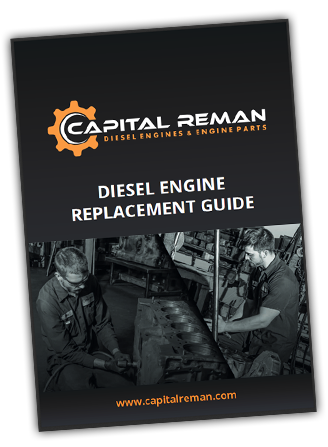Cummins ISX History
 For 16 years now the Cummins ISX Engine has been the flagship diesel engine in Cummins Fleet. The engine is a workhorse but not without its issues.
For 16 years now the Cummins ISX Engine has been the flagship diesel engine in Cummins Fleet. The engine is a workhorse but not without its issues.
The Cummins ISX Engine first debuted in 2001 replacing the popular N14 Series. The Cummins N14 was a fantastic engine and beloved by diesel fans for many years. The only reason for the discontinuation of the engine was the EPA passed stricter emissions regulations that made the N14 outdated. The ISX was originally called the “Signature” series due to the revolutionary fuel system known as the “Interact System” The IS in ISX stands for the Interact System and is in use for on-highway applications. Consequently the QSX or “Quantum System” is used in off-highway applications of the engine such as industrial, generators, pumps, oil & gas, agriculture and marine engines.
The ISX engine makes 430-620 hp with a maximum 2050 lb-ft of torque. The QSX engine produces 375-665 hp with a maximum 1875 lb-ft of torque. Cummins briefly produced a version of the ISX especially for RV applications which made 650 hp at 1950 lb-ft of torque. The engine was discontinued because it was proven to be unreliable. There was also no extended warranty coverage for the RV engines. Cummins had several workarounds for various issues but eventually decided it was not profitable. In 2010 the ISX engine was redesigned once again to accommodate improvements in the emissions technology. From 2001-2010 the engine was a dual overhead camshaft design where one cam triggered the injectors and the other the valve train components. The high pressure injection system is cam actuated to create injection pressure. The fuel system of the ISX is quite complicated encompassing the gear pump, pressure regulators, shutoff valve, lift pump and timing meters to deliver pressurized fuel to the injectors. The 2010 the ISX redesign centered around a single overhead camshaft. The innovation of the common rail fuel system eliminated the need to have the pressurized fuel from an injector camshaft. With the common rail fuel system diesel fuel is pressurized from a multiple piston pump where it is then distributed through tubing to a rail system where it is stored under high pressures up to 30,000-35,000 psi. The change in the fuel system allowed for great fuel economy and thus reduced emissions.
In 2010 the ISX engine was redesigned once again to accommodate improvements in the emissions technology. From 2001-2010 the engine was a dual overhead camshaft design where one cam triggered the injectors and the other the valve train components. The high pressure injection system is cam actuated to create injection pressure. The fuel system of the ISX is quite complicated encompassing the gear pump, pressure regulators, shutoff valve, lift pump and timing meters to deliver pressurized fuel to the injectors. The 2010 the ISX redesign centered around a single overhead camshaft. The innovation of the common rail fuel system eliminated the need to have the pressurized fuel from an injector camshaft. With the common rail fuel system diesel fuel is pressurized from a multiple piston pump where it is then distributed through tubing to a rail system where it is stored under high pressures up to 30,000-35,000 psi. The change in the fuel system allowed for great fuel economy and thus reduced emissions.
The emission systems on the ISX are complex to say the least. The design was one of the first heavy duty diesel engines to incorporate an EGR Cooler (Exhaust Gas Recirculation) system into the engine. The EGR cooler takes exhaust gas and recirculates it back into the intake chamber. The presence of cooled exhaust gas lowers the temperature in the combustion chamber thus reducing NOx particles. The EGR Cooler technology was the first introduced in 2002
The next piece of emissions technology appeared in 2008 in the ISX 871 with the introduction of the Diesel Particulate Filter or (DPF). The DPF traps particulate exhaust matter produced in the combustion chamber. The soot is neutralized through the chemical process known as oxidation. The soot is oxidized and turned into a fine dust which is then regenerated through the turbo. The process is called regeneration. There have been many complaints throughout the years that the SCR is much too complicated and interferes with the horsepower of the engine. With addition of this technology comes many new revolving parts which can fail easily and be very costly to repair. Over the years the ISX Engine has continued to add newer emissions technology to meet changing EPA regulations. In 2010 the ISX15 was the first Cummins engine to feature the Selective Catalytic Reduction system (SCR). The SCR works by injecting Urea directly into exhaust. Urea is the active ingredient in Diesel Exhaust Fluid (DEF). The ammonia based urea chemically reacts with the NOx emission particles and coverts the compound into nitrogen and water within the catalytic converter. The SCR consists of a holding tank, pump, electronic controller and injector nozzle. The DEF is heated in the holding tank, pumped to an injector which injects the fluid into a decomposition tube which reacts with the NOx in the exhaust. There have been many issues with the emission technology over the years. One of the common problems with the ISX is that exhaust which is recirculated back into the engine clogs up the inlet of the turbo during regeneration. When this happens loss of horsepower can occur or more rarely complete engine failure.
Over the years the ISX Engine has continued to add newer emissions technology to meet changing EPA regulations. In 2010 the ISX15 was the first Cummins engine to feature the Selective Catalytic Reduction system (SCR). The SCR works by injecting Urea directly into exhaust. Urea is the active ingredient in Diesel Exhaust Fluid (DEF). The ammonia based urea chemically reacts with the NOx emission particles and coverts the compound into nitrogen and water within the catalytic converter. The SCR consists of a holding tank, pump, electronic controller and injector nozzle. The DEF is heated in the holding tank, pumped to an injector which injects the fluid into a decomposition tube which reacts with the NOx in the exhaust. There have been many issues with the emission technology over the years. One of the common problems with the ISX is that exhaust which is recirculated back into the engine clogs up the inlet of the turbo during regeneration. When this happens loss of horsepower can occur or more rarely complete engine failure.
In 2016 Cummins announced the creation of a new line of heavy-duty engines; the X12 and X15. The new line of engines will meet the 2017 EPA guidelines and offer a 3% increase in fuel efficiency over the ISX. The new models will come with 405-605 horsepower. The ISX is here to stay for quite awhile and, at this time, Cummins has no plans to phase out the older ISX technology.


 Brian is one of the original
co-founders and owners of Capital Reman. Over Capital Reman’s history, Brian has worked in nearly all aspects of the business &
industry to include sales, technical resolution, partner development, practice/policy development, and core management. Today,
Brian spends most of his time leading and developing business opportunities to further enhance and position Capital Reman as a
leader in the Heavy Duty Diesel Remanufacturing space.
Brian is one of the original
co-founders and owners of Capital Reman. Over Capital Reman’s history, Brian has worked in nearly all aspects of the business &
industry to include sales, technical resolution, partner development, practice/policy development, and core management. Today,
Brian spends most of his time leading and developing business opportunities to further enhance and position Capital Reman as a
leader in the Heavy Duty Diesel Remanufacturing space.

